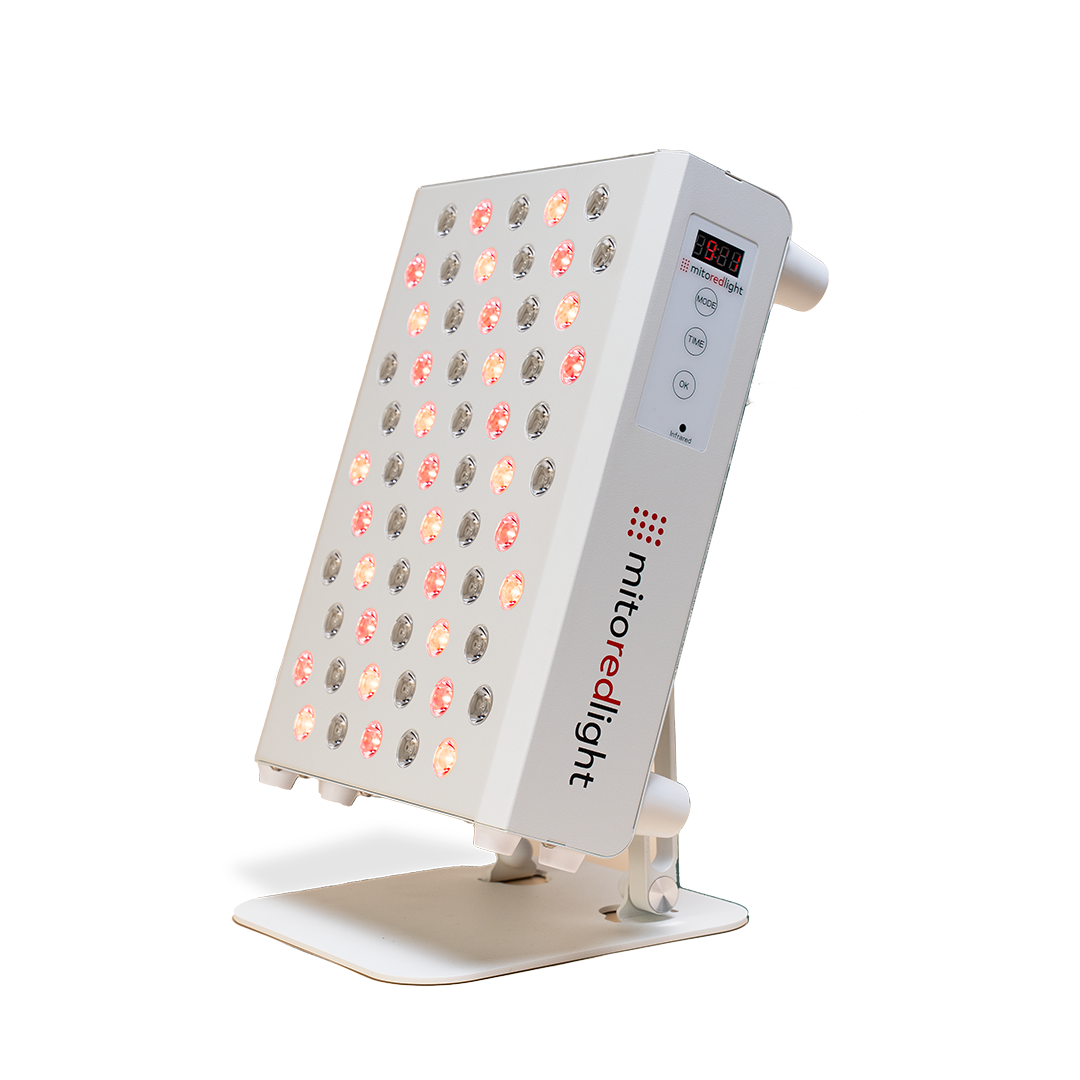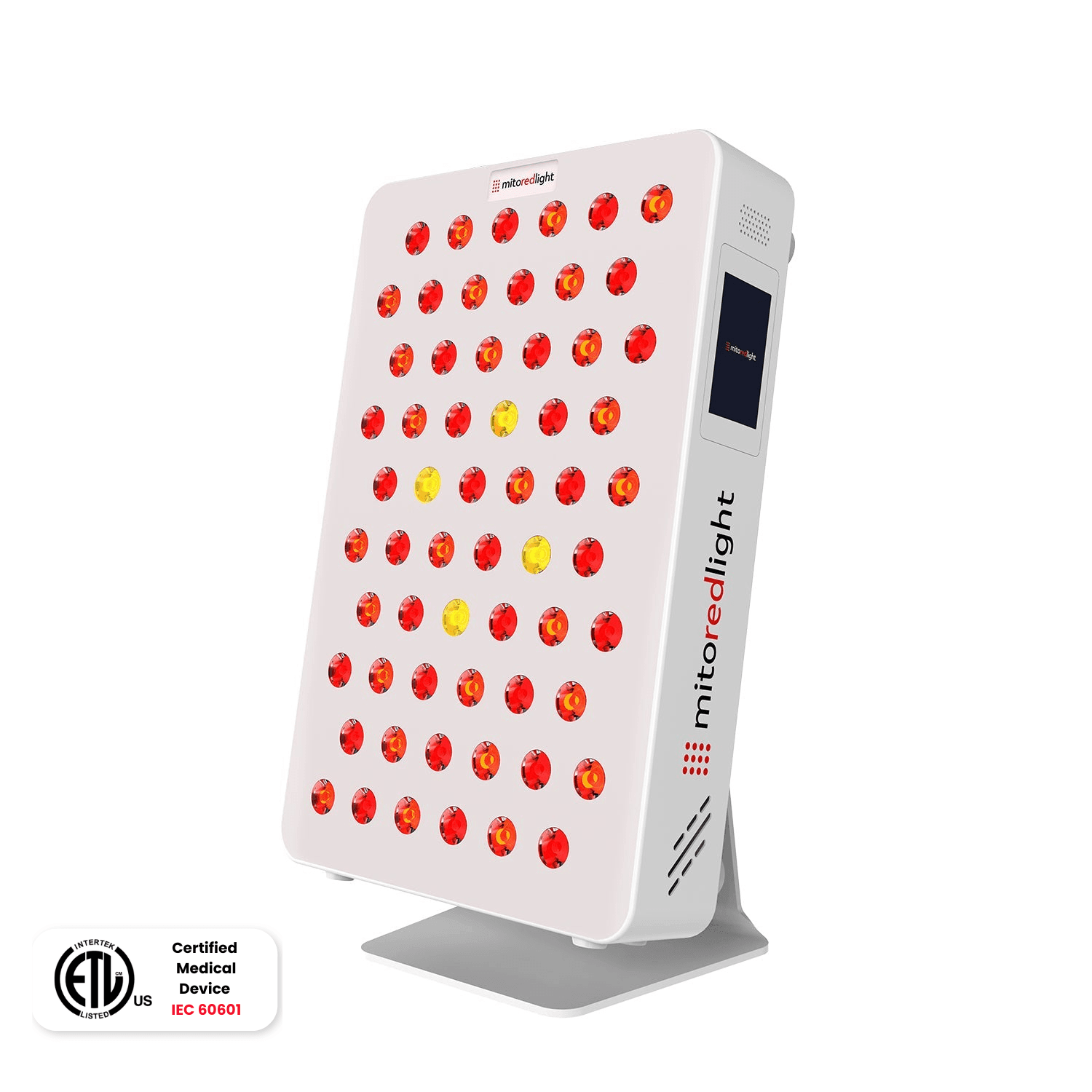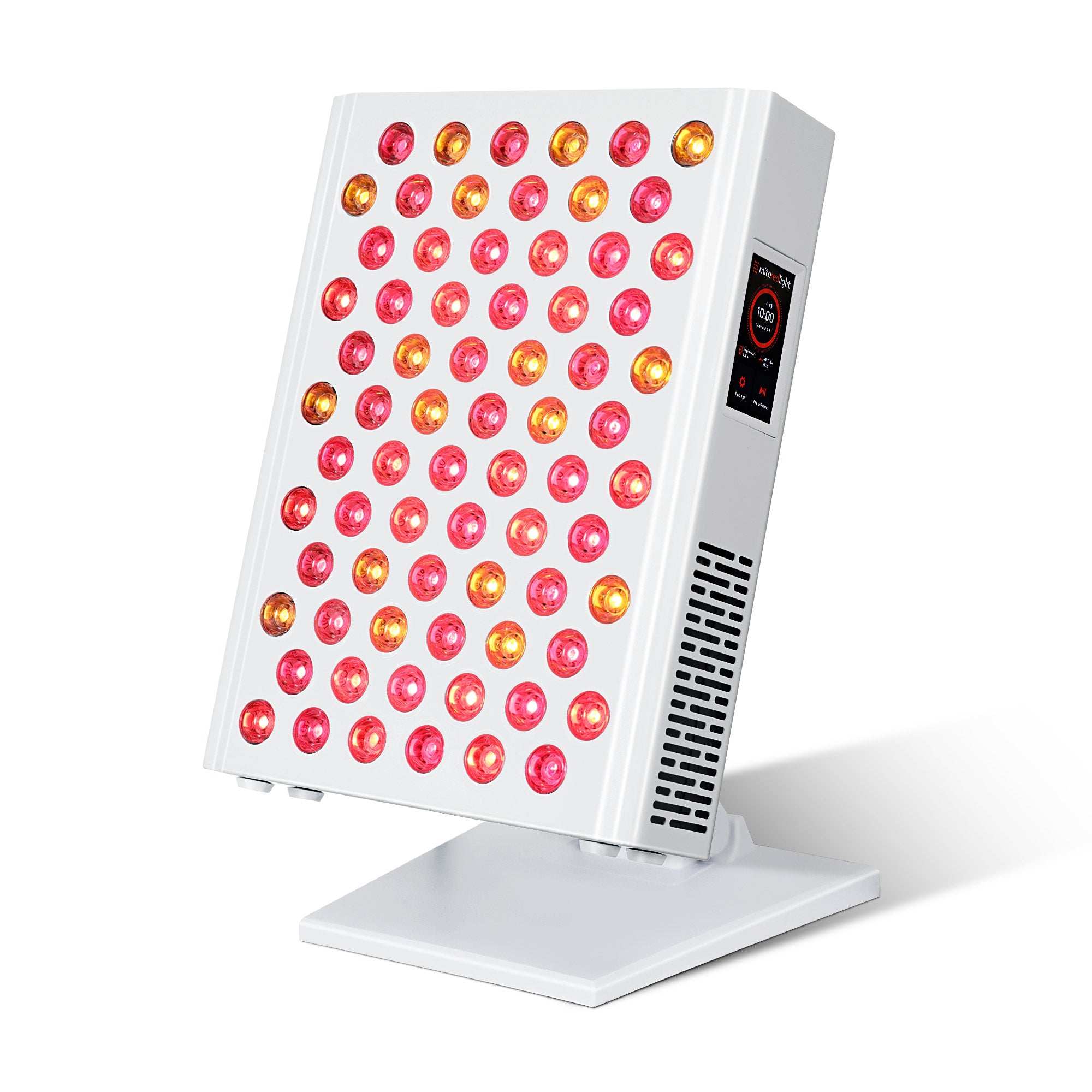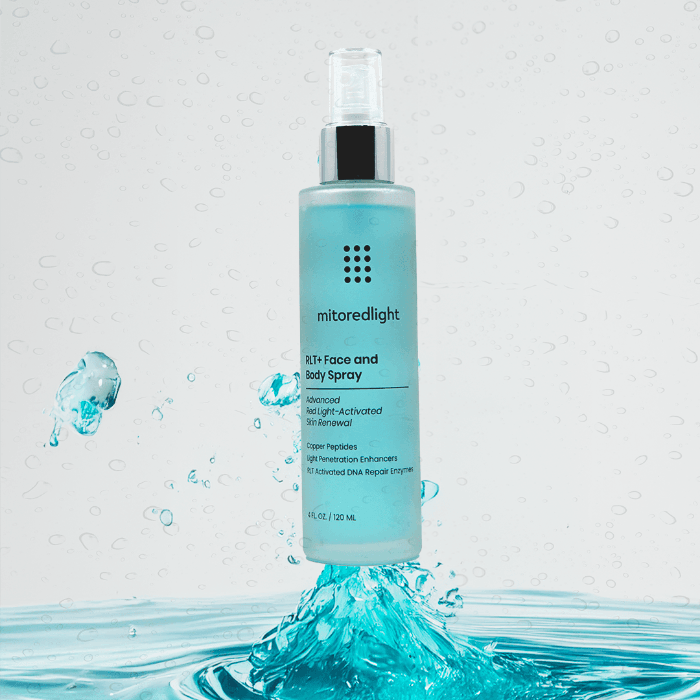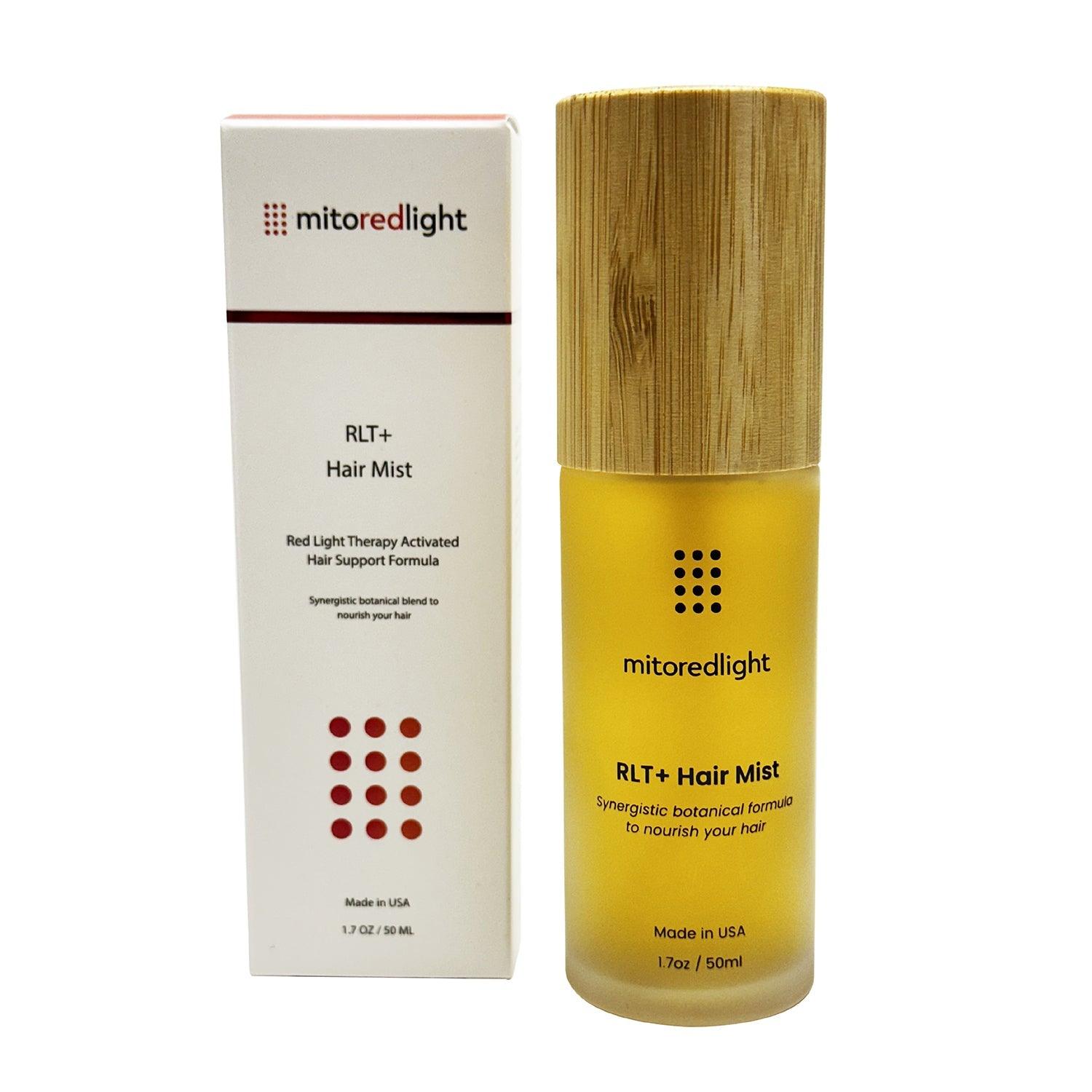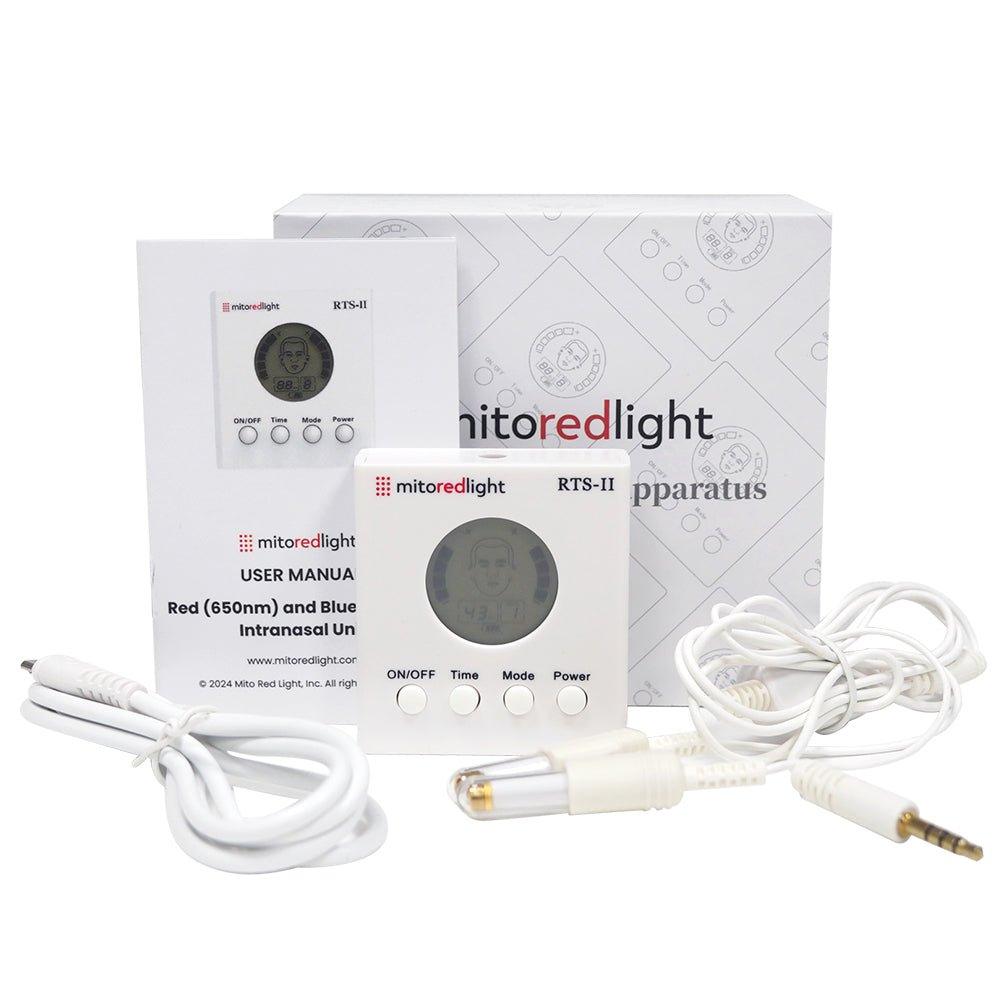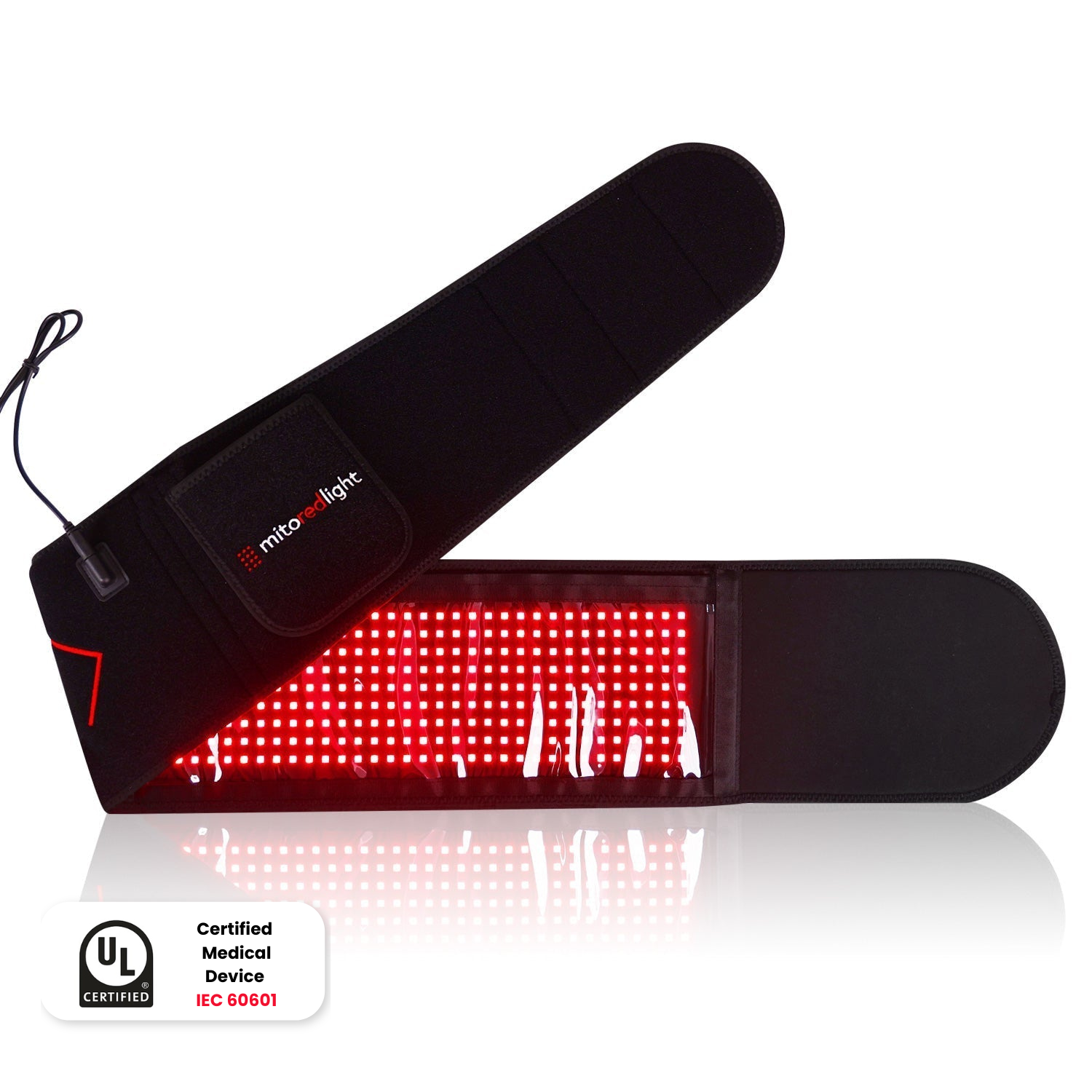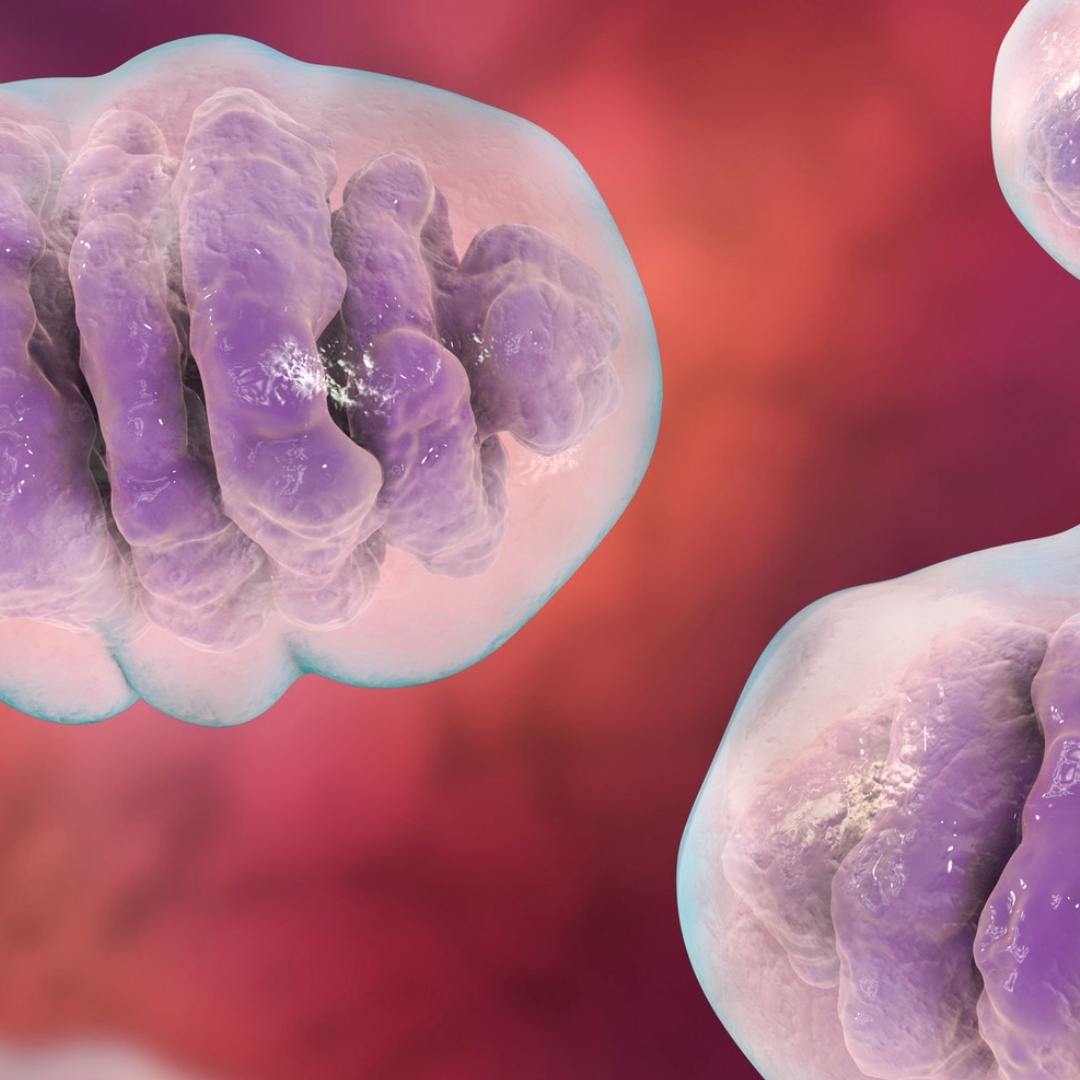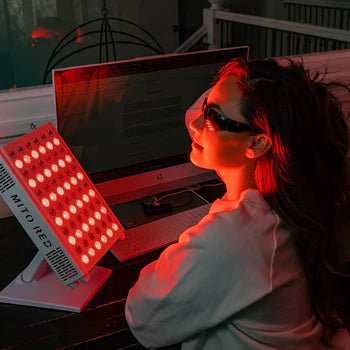MitoAURA™ Face and Body Spray - Level Up Your Red Light Therapy
Article at a Glance
- Red light therapy stimulates collagen production, enhances cellular repair, and reduces inflammation for healthier, more youthful skin.
- MitoAURA™ face and body spray enhances red light therapy by optimizing light absorption, extending penetration, and amplifying skin rejuvenation effects.
- Lumenzyme™ technology with light activated DNA repair enzymes (photolyases). Photolyases use light energy to recognize and directly repair DNA lesions—addressing photodamage at its molecular source. By reversing the effects of UV and pollution-induced DNA injury, LUMENZYME™ helps protect long-term skin health.
- Photoconversion technology in spirulina allows it to absorb red light and re-emit it at optimized wavelengths, increasing its therapeutic reach.
- Antioxidants helps neutralize oxidative stress (including oxidative stress that may be created from red light therapy), prevent premature aging, and support skin hydration.
- A synergistic approach combining red light therapy with advanced skincare formulations like MitoAURA™ Face and Body Spray leads to deeper, longer-lasting results.
The combination of advanced skincare formulations and light therapy is revolutionizing how people think about skin health. Red light therapy (RLT), a non-invasive treatment that harnesses specific wavelengths of light to stimulate cellular function, has gained immense popularity for its ability to promote collagen production, accelerate tissue repair, and reduce inflammation.
Maximizing the benefits of red light therapy can depend on more than just exposure to the right wavelengths, it can also include how well the skin can absorb and respond to this light energy. This is where spirulina-infused spray has shown recent promise.
By leveraging the unique properties of spirulina platensis extract and other bioactive ingredients, advanced body formulations may enhance light penetration, optimize cellular response, and provide antioxidant protection. Research indicates spirulina-infused sprays may work in synergy with red light therapy, creating an ideal environment for the skin to absorb therapeutic light while amplifying its rejuvenating effects.
In this article, we will explore how spirulina and other key ingredients can elevate your red light therapy experience, potentially leading to improved skin health, resilience, and radiance.
Understanding Red Light Therapy and Its Benefits
Red light therapy is a science-backed skincare and wellness treatment that uses low-level red and near-infrared (NIR) wavelengths to stimulate cellular energy production and repair. Originating from NASA research [1] into wound healing and tissue regeneration, red light therapy has since been widely adopted in dermatology, physiotherapy, and holistic wellness because of its profound impact on the body’s natural healing processes.
Unlike ultraviolet rays, which can damage the skin, red and NIR light penetrate deep into the skin without causing harm. They are known to stimulate energy production within cells, and many of the positive effects of red light therapy are believed to come from this effect. This increase in cellular energy is thought to fuel collagen synthesis, tissue repair, and anti-inflammatory responses, making red light therapy an effective, non-invasive solution for various skin concerns.
How Red Light Therapy Works at the Cellular Level
At the core of red light therapy’s effectiveness is its interaction with mitochondria [2], tiny organs inside of cells that serve as the powerhouse of the cell. When skin is exposed to specific red and NIR wavelengths, chromophores (light-absorbing molecules) within the mitochondria absorb the light, leading to enhanced energy production. This increased energy output is believed to drive cellular repair and regeneration, improving overall skin health
Additionally, red light therapy stimulates the activity of fibroblasts, the cells responsible for producing collagen and elastin, both of which are essential proteins for maintaining skin structure and elasticity. As a result, many people report that regular red light therapy sessions can lead to smoother, firmer, and more youthful-looking skin.
Red light therapy is also believed to help reduce oxidative stress and inflammation, both of which contribute to premature aging and skin damage. By lowering the levels of harmful reactive oxygen species and promoting better circulation, red light therapy supports a clearer, healthier complexion and enhances skin resilience over time.
Key Skin and Wellness Benefits of Red Light Therapy
Red light therapy is becoming increasingly popular for a wide array of skin and wellness benefits, making it a versatile solution for those seeking natural, effective skin rejuvenation. Here are some of the most notable advantages:
-
Boosts collagen production - Increased collagen production improves skin elasticity and firmness, reducing the appearance of fine lines and wrinkles.
-
Enhances wound healing - The effects of red light therapy have been found to support tissue repair and cell regeneration for faster recovery from cuts, burns, and abrasions.
-
Reduces Inflammation - Anti Inflammatory effects can reduce redness, irritation, and inflammatory skin conditions like acne and rosacea.
-
Improves skin hydration - Better skin health leads to better moisture retention, leading to softer, more supple skin.
-
Fades hyperpigmentation - Red light therapy is often used to even out skin tone and reduce the appearance of age spots and sun damage.
-
Supports hair growth - Red light therapy is becoming increasingly popular for stimulating hair follicles, aiding in the treatment of thinning hair and hair loss.
-
Relieves muscle pain - It is commonly used to address muscle soreness and enhances recovery after exercise.
-
Enhances circulation - Better blood flow helps in delivering oxygen and nutrients to skin cells for improved vitality.
By regularly incorporating red light therapy into your routine, you may be able to achieve healthier, more youthful-looking skin while benefiting from its overall wellness-boosting effects.
The Science Behind Spirulina and Its Role in Skin Health
Red light therapy has long been recognized for its ability to enhance cellular function, but when paired with bioactive skincare formulations, its benefits can be amplified. Spirulina, a nutrient-dense microalga, has emerged as a powerful ingredient in skincare due to its ability to support skin rejuvenation, collagen synthesis, and antioxidant defense [3]. Spirulina’s unique composition makes it an ideal complement to red light therapy, helping to extend the effectiveness of light-based treatments and optimize skin health.
What is Spirulina?
Spirulina is a blue-green microalga that has been used for centuries as a superfood due to its exceptional nutritional profile. It is rich in proteins, vitamins, minerals, and antioxidants, all of which contribute to skin nourishment and cellular repair. While it has traditionally been consumed as a dietary supplement, recent advancements in skincare science have unlocked its potential for topical application, revealing potentially powerful anti-aging and restorative properties.
One of spirulina’s most valuable characteristics is its high concentration of chromophores—light-absorbing molecules that interact with specific wavelengths of light. These include chlorophylls, phycobilins, and carotenoids, which play a crucial role in light absorption and photoconversion. When exposed to red and near-infrared light, spirulina’s natural chromophores can absorb and re-emit light energy, potentially amplifying the effects of red light therapy at a cellular level.
Bioactive Compounds in Spirulina
Spirulina’s benefits extend beyond its ability to enhance red light absorption [4]. It is packed with a range of bioactive compounds that contribute to overall skin health, including:
-
Phycocyanin - A potent antioxidant with anti-inflammatory properties that helps combat oxidative stress and supports cell regeneration.
-
Beta-carotene - A precursor to Vitamin A that promotes collagen synthesis and enhances skin elasticity.
-
Essential amino acids - Building blocks for protein synthesis that support skin structure and repair.
-
Gamma-linolenic acid (GLA) - A rare fatty acid that helps maintain skin hydration and barrier function.
-
Minerals (Iron, zinc, copper, magnesium) - Essential cofactors for enzymatic reactions involved in skin repair and collagen production.
These compounds work in synergy to protect the skin from environmental stressors, support collagen production, and optimize cellular energy metabolism. All of these effects are important for maximizing the benefits of red light therapy.
Scientific Findings on Spirulina for Skin Rejuvenation
Scientific research has demonstrated that spirulina’s bioactive components can contribute to anti-aging, anti-inflammatory, and skin-repairing effects. Studies suggest that spirulina extract can stimulate collagen production, reduce fine lines and wrinkles, and improve skin elasticity. Furthermore, its antioxidant and anti-inflammatory properties make it a valuable ingredient in soothing irritated or sensitive skin.
Some of the key findings on spirulina’s role in skin rejuvenation include:
-
Enhances collagen production - Stimulates fibroblast activity, promoting skin firmness and elasticity [5].
-
Reduces wrinkles and fine lines - Supports skin renewal and minimizes visible signs of aging.
-
Boosts hydration and skin barrier function - Helps retain moisture and reinforces the skin’s protective barrier.
-
Protects against oxidative stress - Neutralizes free radicals to prevent premature aging [6].
The presence of chlorophylls and phycobilins in spirulina can further enhance light absorption and re-emission, making it a potentially powerful companion ingredient for red light therapy.
Spirulina as a Natural Chromophore
One of the most unique aspects of spirulina is its role as a natural chromophore, a molecule that absorbs and emits light energy. When spirulina extract is exposed to red and near-infrared light, its chromophores absorb the light at specific wavelengths and re-emit it at broader, deeper-penetrating wavelengths [7]. This process, known as photoconversion, allows red light therapy to reach deeper layers of the skin, enhancing collagen stimulation, mitochondrial activity, and tissue repair.

By incorporating spirulina-infused spray into a red light therapy skincare regimen, users can extend the therapeutic range of red light therapy, ensuring deeper penetration and prolonged benefits. This can make spirulina a key ingredient in enhancing skin vitality, reducing inflammation, and maximizing cellular energy production.
How Spirulina Enhances the Effects of Red Light Therapy
Red light therapy is a powerful tool for skin rejuvenation, cellular repair, and overall wellness. However, its effectiveness can be further amplified with the right topical ingredients. Spirulina, a microalga packed with antioxidants, bioactive compounds, and chromophores, plays an important supportive role in optimizing the skin’s ability to absorb and utilize red light.
Photoconversion Technology – Extending Light Penetration
One of the most significant ways spirulina enhances red light therapy is through photoconversion technology. Photoconversion is a process in which certain molecules absorb light energy and then re-emit it at a different wavelength, allowing for deeper tissue penetration and prolonged therapeutic effects.
Spirulina is rich in chromophores such as chlorophylls, phycobilins, and beta-carotene, which are highly efficient at absorbing light within the red and red-yellow light. When spirulina-infused spray is applied to the skin before red light therapy exposure, these chromophores capture red light photons and re-emit them at optimized wavelengths, extending the reach of red and NIR light deeper into the skin. This means that more cells receive the therapeutic benefits of red light, potentially leading to enhanced collagen production, tissue repair, and mitochondrial energy output.
Collagen Synthesis and Skin Firmness
Collagen is the foundation of youthful skin, providing structure, firmness, and elasticity. However, as we age, collagen production declines, leading to wrinkles, sagging, and loss of skin density. Red light therapy is well known for its ability to stimulate fibroblasts, the cells responsible for collagen synthesis. When combined with spirulina-infused formulations, its collagen-boosting effects are significantly enhanced.
Spirulina contains amino acids, copper peptides, and beta-carotene, which are all essential for collagen remodeling. When applied before red light therapy exposure, spirulina can help accelerate fibroblast activity, leading to increased collagen and elastin production, and protecting against collagen degradation by neutralizing enzymes that break down collagen.
By regularly incorporating spirulina-infused spray with red light therapy, users may see firmer, more resilient skin with improved texture and tone. The combination of red light therapy and spirulina can contribute to:
-
Increased skin elasticity - Preventing sagging and maintaining youthful firmness.
-
Reduction in fine lines and wrinkles - Supporting smoother, more supple skin.
-
Enhanced skin hydration - Strengthening the skin barrier for long-term moisture retention.
The synergistic approach of combining red light therapy and spirulina ensures that red light therapy delivers long-lasting, visible skin improvements.
Antioxidant Protection Against Oxidative Stress
One of the lesser-known challenges of red light therapy is that, while it boosts cellular activity, it can also increase the potential for oxidative stress due to heightened mitochondrial function. When cells produce more energy, they also generate reactive oxygen species (ROS), which can contribute to premature aging and inflammation if left unbalanced.
Spirulina is an antioxidant powerhouse packed with phycocyanin, beta-carotene, and polyphenols. All of these ingredients help neutralize free radicals and protect against oxidative damage [8]. When applied before red light therapy, spirulina can:
-
Act as a ROS scavenger - Prevents oxidative stress from accumulating in skin cells.
-
Reduce DNA damage - Ensures cellular integrity and longevity.
-
Enhance skin resilience - Strengthens the skin’s natural defense mechanisms.
However, it's not just Spirulina the MitoAURA is jam-packed with synergistic antioxidant compounds.


By pairing these synergistic antioxidants with red light therapy, users can experience all the benefits of red light therapy while reducing any risk of oxidative stress-related skin damage. The logic here is to increase the net-benefit of the light therapy.
In our own in house split-face product study*, pairing an antioxidant rich serum with red light therapy improved skin MORE health across 5 key measures, vs red light therapy alone. You can read more about that study here:
https://mitoredlight.com/blogs/mito-red-blog/supercharge-your-red-light-therapy-for-skin-rejuvenation
*Please note: this was a small product study not a randomized clinical trial. Nevertheless the results were promising and support the theory that pre-conditioning the skin with exogenous antioxidants may lead to enhanced skin benefits from red light therapy.
Anti-Inflammatory and Skin-Calming Effects
Inflammation is a key factor in many skin conditions, including redness, sensitivity, acne, and premature aging. While red light therapy has natural anti-inflammatory properties, combining it with spirulina-infused skincare enhances its ability to soothe irritation and calm the skin.
Spirulina contains anti-inflammatory compounds, including gamma-linolenic acid (GLA) and phycocyanin, both of which help:
-
Reduce redness and swelling - This makes it ideal for sensitive or reactive skin.
-
Soothe post-treatment irritation - Helping the skin recover more quickly after red light therapy.
-
Support overall skin balance - Promoting a calm, even complexion.
By applying spirulina-infused spray before or after red light therapy, users can experience greater comfort, reduced inflammation, and a more effective healing response—making red light therapy even more suitable for individuals with sensitive or compromised skin.
The Power of Synergistic Ingredients in MitoAURA™ Face and Body Spray
The effectiveness of red light therapy is can be enhanced when paired with scientifically formulated skincare products. MitoAURA™ Face and Body Spray is formulated with a powerful combination of ingredients that are designed to work synergistically to amplify light absorption, boost collagen production, and protect the skin from oxidative stress. Each ingredient plays a unique role in enhancing red light therapy’s benefits, ensuring optimal skin rejuvenation and overall skin health.
-
Spirulina Extract - A potent superfood for the skin, spirulina is rich in chromophores, including chlorophylls, phycobilins, and beta-carotene, which optimize red light absorption. It can facilitate photoconversion, extending the therapeutic reach of red light therapy while providing antioxidant protection and anti-inflammatory benefits.
-
Copper Tripeptide-1 - A bioactive peptide that stimulates collagen synthesis and cellular repair [9]. It reinforces the extracellular matrix, helping to firm and tighten the skin while accelerating healing processes. When combined with red light therapy, it can enhance skin resilience and elasticity.
-
Plankton Extract - Derived from marine microalgae, this extract contains light-activated enzymes (photolyases) that help repair DNA damage [10] caused by oxidative stress and environmental factors. It can work synergistically with red light therapy by activating cellular repair processes, resulting in smoother, healthier skin.

-
Chamomilla Recutita (Chamomile) Flower Extract - A well-known anti-inflammatory botanical [11], chamomile soothes sensitive and irritated skin, reducing redness and discomfort. Its antioxidant properties help protect against oxidative damage, making it a good complement to post-red light therapy skin care.
-
Aloe Barbadensis (Aloe Vera) Leaf Juice - Aloe vera is packed with hydrating, cooling, and skin-repairing properties. It provides deep moisture, enhances skin healing, and has anti-inflammatory effects [12] that help the skin stay healthy. Aloe vera also supports collagen production, ensuring a smoother and more youthful complexion.
-
Nicotinamide Mononucleotide (NMN) - A cellular longevity booster, NMN plays a critical role in energy metabolism and DNA repair. It supports mitochondrial health [13], working in synergy with red light therapy to enhance ATP production, leading to revitalized and youthful-looking skin.
-
Cucumis Sativus (Cucumber) Fruit Extract - Known for its soothing and hydrating properties, cucumber extract reduces puffiness, cools the skin, and delivers antioxidants that protect against environmental stressors. It complements red light therapy by enhancing hydration and reducing post-treatment redness.
-
Helianthus Annuus (Sunflower) Sprout Extract - Rich in antioxidants, fatty acids, and vitamins, sunflower sprout extract fights oxidative stress [14], boosts collagen synthesis, and improves skin resilience. It helps shield the skin from premature aging while supporting the cellular repair processes stimulated by red light therapy.
-
Coccinia Indica (Ivy Gourd) Fruit Extract - A traditional botanical ingredient known for its skin-brightening and antioxidant properties. It helps reduce pigmentation, even out skin tone, and protect against free radicals, making it a great addition to a red light therapy-enhancing formula.
-
Eclipta Prostrata Extract - An herbal extract with anti-inflammatory and wound-healing properties [15], eclipta prostrata helps strengthen the skin barrier, promoting a healthy, balanced complexion. It aids in calming the skin post-red light therapy exposure.
-
Ascorbic Acid (Vitamin C) - A potent antioxidant and collagen booster [16], vitamin C protects the skin from oxidative stress while enhancing collagen synthesis. When combined with red light therapy, it can help brighten the complexion, even skin tone, and boost overall skin radiance.
-
Glycerin - A powerful humectant that attracts and locks in moisture, glycerin ensures deep hydration and helps maintain a plump, youthful complexion [17]. It also supports the skin barrier, preventing moisture loss post-red light therapy treatments.
-
Maltodextrin - A stabilizing and soothing agent, maltodextrin helps to enhance the penetration of active ingredients while offering hydrating and calming effects on the skin.
-
PEG-12 Dimethicone - A lightweight silicone-based ingredient, PEG-12 dimethicone forms a protective barrier on the skin, helping to retain moisture and shield the skin from environmental pollutants. It provides a smooth, non-greasy texture ideal for skincare applications before and after red light therapy.
-
Isoprene Glycol - A moisture-binding ingredient that helps improve skin hydration and absorption of active ingredients. It works synergistically with humectants like glycerin, ensuring a deeply moisturized and supple skin surface post-red light therapy.
-
Caprylyl Glycol - An emollient and skin-conditioning agent, caprylyl glycol enhances hydration, smoothness, and product absorption [18]. It helps maintain the skin’s moisture balance, making it a good supporting ingredient for red light therapy-enhancing formulations.
-
Lecithin - A phospholipid with skin-restoring properties, Lecithin enhances ingredient penetration and moisture retention. It helps keep the skin soft, smooth, and well-nourished, working alongside red light therapy to support long-term skin health and repair.
This carefully curated blend of ingredients makes MitoAURA™ Face and Body Spray an essential companion to any red light therapy routine. By combining hydrating, collagen-boosting, and antioxidant-rich compounds, this advanced formulation ensures optimal light absorption, deeper cellular rejuvenation, and long-term skin health benefits.
How to Use MitoAURA Spray with Red Light Therapy for Maximum Benefits
To maximize the effectiveness of red light therapy, proper skin preparation and post-treatment care are essential. MitoAURA™ Face and Body Spray is formulated to enhance light absorption, optimize cellular response, and provide essential hydration and protection. By integrating this spray into your red light therapy routine, you can ensure more noticeable, longer-lasting results.
Pre-Treatment Application for Optimal Absorption
For the best results, it’s best to apply MitoAURA™ Face and Body Spray before your red light therapy session. This ensures that the active ingredients penetrate the skin, preparing it for enhanced light absorption and deeper cellular activation.
-
Start with a clean face and body. Wash your skin to remove impurities, makeup, and excess oil. A clean surface allows the spray’s active ingredients to absorb effectively.
-
Spray a light, even layer onto the targeted areas of your skin. The lightweight formula ensures quick absorption without leaving residue.
-
Allow the spray to fully absorb before starting your red light therapy session. This enhances photoconversion, collagen stimulation, and antioxidant protection.
Frequency and Best Practices for Application
Consistency is key to achieving optimal skin rejuvenation and long-term improvements with red light therapy. When using MitoAURA™ Face and Body Spray, consider the following best practices:
-
Daily or Regular Use - For best results, apply the spray before each red light therapy session. If using red light therapy daily or multiple times per week, the spray can be used accordingly to enhance results.
-
Targeted Application - The spray can be used on the face, neck, décolletage, and any areas prone to wrinkles, loss of firmness, or skin damage. For body treatments, apply to areas experiencing dryness, aging signs, or muscle soreness.
-
Combination with Other Skincare Products - After red light therapy, you can follow up with a moisturizer or serum to lock in hydration. Avoid using harsh exfoliants or retinoids immediately before or after red light therapy sessions to prevent sensitivity.
By incorporating MitoAURA™ Face and Body Spray into your routine, you can amplify the benefits of red light therapy, ensuring enhanced collagen production, deeper hydration, and long-lasting skin improvements.
The Future of Skincare: Combining Light Therapy with Advanced Formulations
As skincare science continues to evolve, the fusion of bioactive ingredients with innovative technologies like red light therapy is setting new standards for skin rejuvenation. The future of optimal skincare is no longer limited to single solutions alone; it is about using a holistic combination of approaches to harness the body’s natural ability to heal, regenerate, and optimize cellular function.
By integrating targeted, high-performance ingredients like spirulina and antioxidant-rich botanical extracts into skincare, red light therapy users can amplify their results, ensuring deeper hydration, enhanced collagen production, and long-term protection against environmental stressors.
The Rise of Bioactive Skincare and Light Therapy Synergy
The skincare industry is witnessing a remarkable shift toward bioactive formulations that work synergistically with external treatments like red light therapy. This new wave of skincare innovation is driven by a deeper understanding of cellular function, the role of mitochondria, and the science of photobiomodulation.
Combining red light therapy with scientifically formulated skincare products enhances its effects by preparing the skin for optimal light absorption, extending the therapeutic benefits of treatment, and protecting against oxidative stress.
Key trends fueling the rise of bioactive skincare and light therapy synergy include:
-
Targeted photoconversion ingredients - Bioactives like spirulina, rich in chromophores, help extend light penetration, ensuring deeper-reaching effects.
-
Antioxidant-powered protection - Ingredients such as vitamin C, copper peptides, and botanical extracts neutralize free radicals, countering the oxidative stress that may arise from increased mitochondrial activity during red light therapy.
-
Collagen-boosting peptides & growth factors - Skincare products infused with collagen-stimulating peptides enhance skin firmness, making red light therapy results even more visible.
-
Hydration and skin barrier enhancement - Skin care products including ingredients like hyaluronic acid, glycerin, and lipid-rich ingredients support moisture retention and barrier repair.
-
Customizable Skincare Routines - Consumers are now layering bioactive serums, mists, and post-red light therapy recovery formulas, allowing for a personalized approach to skin health.
By adopting these advancements into their skincare routines, red light therapy users can take their skincare to the next level, achieving superior results.
Why MitoAURA™ Face and Body Spray is a Game-Changer
The MitoAURA™ Face and Body Spray is more than just a skincare product—it’s a performance-enhancing formula designed to work seamlessly with red light therapy. Preparing, protecting, and optimizing the skin allows users to maximize the full potential of their red light therapy treatments, ensuring faster, longer-lasting, and more noticeable skin improvements.
Unique Formulation for Maximized RLT Benefits
What sets MitoAURA™ Face and Body Spray apart is its precisely curated blend of light-enhancing, collagen-boosting, and antioxidant-rich ingredients. This unique formulation is designed to:
-
Extend the potential therapeutic range and effect of red light, allowing for deeper penetration and cellular activation.
-
Neutralize oxidative stress, ensuring that cells regenerate efficiently under optimal conditions.
-
Strengthen the skin barrier and lock in hydration, providing long-lasting post-treatment nourishment.
Unlike standard facial mists or serums, this spray interacts with light and is specifically engineered to work in harmony with light-based treatments, making it an essential tool for achieving transformative results with red light therapy.
Easy Integration into Any Skincare and RLT Routine
The MitoAURA™ Face and Body Spray is designed for effortless integration into existing skincare and red light therapy regimens, making it accessible and effective for all users. Whether you’re a beginner to red light therapy or a long-time enthusiast, incorporating this powerful spray into your routine is simple and highly beneficial.
By making MitoAURA™ Face and Body Spray a consistent part of your skincare regimen, you can ensure that your skin receives the highest level of nourishment while using red light therapy and supporting your skin’s long-term firmness, hydration, and overall radiance.
Mito Red Light
Effective red light therapy requires high-quality products and expert guidance. At Mito Red Light, we offer high-quality red light therapy panels specifically designed to help you meet your skincare goals. Our selection of red light therapy panels is ideal for anyone wanting to improve the appearance of their skin and offers an important step towards achieving smoother skin and a healthier lifestyle.
We invite you to review our selection of high-quality products or to contact one of our helpful representatives at 1-866-861-6486(MITO) to learn more about our products.
DISCLAIMER: Mito Red Light devices are low / risk general wellness devices aimed at affecting the body through supporting cellular function. The scientific studies referenced in this article are for educational and informational purposes only and are meant to educate the reader on the exciting and growing field of phototherapy. To see a list of precautionary warnings and contraindications, click here.
References:
-
Cotler, H. B. (2015). A NASA discovery has current applications in orthopaedics. Current Orthopaedic Practice, 26(1), 72–74. https://doi.org/10.1097/BCO.0000000000000196
-
Tafur, J., & Mills, P. J. (2008). Low-intensity light therapy: Exploring the role of redox mechanisms. Photomedicine and Laser Surgery, 26(4), 323–328. https://doi.org/10.1089/pho.2007.2184
-
Ragusa, I., Nardone, G. N., Zanatta, S., Bertin, W., & Amadio, E. (2021). Spirulina for skin care: A bright blue future. Cosmetics, 8(1), 7. https://doi.org/10.3390/cosmetics8010007
-
Ikeda, I. K., Sydney, E. B., & Sydney, A. C. N. (2022). Potential application of Spirulina in dermatology. Journal of Cosmetic Dermatology, 21(10), 4205–4214. https://doi.org/10.1111/jocd.14997
-
Machihara, K., Oki, S., Maejima, Y., Kageyama, S., Onda, A., Koseki, Y., Imai, Y., & Namba, T. (2023). Restoration of mitochondrial function by Spirulina polysaccharide via upregulated SOD2 in aging fibroblasts. iScience, 26(7), 107113. https://doi.org/10.1016/j.isci.2023.107113 x
-
Gold, M. H., Goldman, M. P., Biron, J. A., & Weiss, R. A. (2015). Fluorescent light energy: A review and clinical applications in dermatology. Journal of the American Academy of Dermatology, 73(4), 578–592. https://doi.org/10.1016/j.jaad.2015.06.045
-
Yogianti, F., Kunisada, M., Nakano, E., Ono, R., Sakumi, K., Oka, S., Nakabeppu, Y., & Nishigori, C. (2014). Inhibitory effects of dietary Spirulina platensis on UVB-induced skin inflammatory responses and carcinogenesis. Journal of Investigative Dermatology, 134(10), 2610–2619. https://doi.org/10.1038/jid.2014.188
-
Mapoung, S., Arjsri, P., Thippraphan, P., Semmarath, W., Yodkeeree, S., Chiewchanvit, S., Piyamongkol, W., & Dejkriengkraikul, P. (2020). Photochemoprotective effects of Spirulina platensis extract against UVB irradiated human skin fibroblasts. South African Journal of Botany, 130(Suppl 1), 198–207. https://doi.org/10.1016/j.sajb.2020.01.001
-
Anastassakis, K. (2022). Copper Tripeptides . In: Androgenetic Alopecia From A to Z . Springer, Cham. https://doi.org/10.1007/978-3-031-08057-9_22
-
Essen, L. O., & Klar, T. (2006). Light-driven DNA repair by photolyases. Cellular and Molecular Life Sciences, 63, 1266–1277. https://doi.org/10.1007/s00018-006-6019-6
-
Sah, A., Naseef, P. P., Kuruniyan, M. S., Jain, G. K., Zakir, F., & Aggarwal, G. (2022). A comprehensive study of therapeutic applications of chamomile. Pharmaceuticals (Basel), 15(10), 1284. https://doi.org/10.3390/ph15101284
-
Foster, M., Hunter, D., & Samman, S. (2011). Evaluation of the nutritional and metabolic effects of Aloe vera. In I. F. F. Benzie & S. Wachtel-Galor (Eds.), Herbal medicine: Biomolecular and clinical aspects (2nd ed.). CRC Press/Taylor & Francis. https://www.ncbi.nlm.nih.gov/books/NBK92765/
-
Yi, L., Maier, A. B., Tao, R., Lin, Z., Vaidya, A., Pendse, S., Thasma, S., Andhalkar, N., Avhad, G., & Kumbhar, V. (2022). The efficacy and safety of β-nicotinamide mononucleotide (NMN) supplementation in healthy middle-aged adults: A randomized, multicenter, double-blind, placebo-controlled, parallel-group, dose-dependent clinical trial. GeroScience, 45(1), 29–43. https://doi.org/10.1007/s11357-022-00705-1
-
Guo, S., Ge, Y., & Na Jom, K. (2017). A review of phytochemistry, metabolite changes, and medicinal uses of the common sunflower seed and sprouts (Helianthus annuus L.). BMC Chemistry, 11, Article 95. https://doi.org/10.1186/s13065-017-0328-7
-
Timalsina, D., & Devkota, H. P. (2021). Eclipta prostrata (L.) L. (Asteraceae): Ethnomedicinal uses, chemical constituents, and biological activities. Biomolecules, 11(11), Article 1738. https://doi.org/10.3390/biom11111738
-
Abdullah, M., Jamil, R. T., & Attia, F. N. (2023). Vitamin C (ascorbic acid). In StatPearls. StatPearls Publishing. https://www.ncbi.nlm.nih.gov/books/NBK499877/
-
Becker, L. C., Bergfeld, W. F., Belsito, D. V., Hill, R. A., Klaassen, C. D., Liebler, D. C., Marks, J. G., Shank, R. C., Slaga, T. J., Snyder, P. W., Gill, L. J., & Heldreth, B. (2019). Safety assessment of glycerin as used in cosmetics. International Journal of Toxicology, 38(3_suppl), 6S–22S. https://doi.org/10.1177/1091581819883820
-
Lawan, K., Kanlayavattanakul, M., & Lourith, N. (2009). Antimicrobial efficacy of caprylyl glycol and ethylhexylglycerin in emulsion. Journal of Health Research, 23(1), 1–3. https://www.thaiscience.info/journals/Article/JHRE/10893376.pdf
